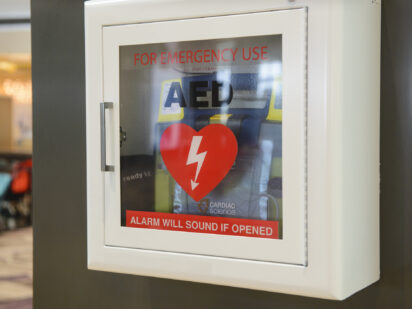Damar Hamlin, a 24-year-old Buffalo Bills safety, went into cardiac arrest on the field in Cincinnati after taking a hit during the Jan. 2 game. Hamlin immediately collapsed upon standing, prompting the Bills’ medical staff to administer emergency medical treatment, which included CPR and an automated external defibrillation (AED). He survived and is still recovering from the incident.
Sudden Cardiac Arrest (SCA) is a life-threatening emergency caused by the sudden loss of all heart activity due to an irregular heart rhythm. When SCA happens, breathing stops and the person becomes unconscious and may gasp or shake as if having a seizure. Without immediate treatment, SCA can lead to death. Survival depends on people nearby calling 911, starting CPR and using an AED (if available) as soon as possible.
Because his incident occurred on national television, Hamlin, a young, professional athlete, raised public awareness of SCA from a situation that most would interpret as an anomaly. However, the American Heart Association reports that SCA is a leading cause of death in the U.S. There are more than 356,000 out-of-hospital cardiac arrests annually, 90% of them fatal. But what most parents don’t know is that SCA is the number one killer of student athletes. Sports-related SCA accounted for 39% of SCAs among those younger than 18 years of age.
Trinity Health’s Sports Medicine team of certified athletic trainers (ATCs) are trained to respond to any contingency, whether injury management, mass casualty care, concussion management or emergency response. “We have venue specific emergency action plans (EAP) in place at every location where we work,” said Barb Nesheim, a 24-year veteran of Trinity’s Sports Medicine Program. “Our EAPs include the location of the nearest AED at each venue.”
An EAP is a written list of life-saving steps to take when an emergency happens.
North Dakota is one of 17 states that has regulations that require AEDs in schools. However, there is no language that specifically indicates AEDs should be available near athletic fields or during sporting events.
“Although many schools have AEDs on site, access depends on where your athletic event takes place. If you are on the football field at Minot High School, for example, the closest AED is located in the south shed,” Nesheim explained. “In an emergency, ideally you would want to retrieve the AED and return to the victim within three minutes. If that’s not possible, then it’s not in the right place – survival ods decrease by 10% for every minute that passes from the time of collapse.”
North Dakota does not have a law requiring schools to have individual, venue-specific EAPs. Both venue-specific EAPs and AEDs are considered gold standards of healthcare on sports sidelines. Darren Armstrong, manager of Trinity Health Sports Medicine and Exercise Physiology, said that his department created and distributed 45 EAPs throughout Trinity’s service area, based on individual sites.
“Every year, our Sports Medicine team participates in extensive training, where we practice different scenarios that may lead to an injury. It’s our role to help develop the emergency action plans and our role to perform them at optimum level when we are on site. However, we want to partner with our contracts and schools so they can perform to the best of their ability when we are not available,” Armstrong added.
From November through March, Trinity’s staff of 15 ATCs are responsible for covering more than 600 athletic events. “Our athletic trainers are at a number of events and practices, but we are not at all of them,” Armstrong said. Data shows that even when bystanders intervene immediately by giving CPR during SCA, survival rates double or triple.
Partnering comes down to deciding who’s going to help the downed athlete, who is going to call for help, who is going to show the ambulance how to get to the gym,” explained Dawn Mattern, MD, FAMSSM, medical director of Trinity Health Sports Medicine. “Do we know how to access the AED? Those decisions have to be made for each specific site. If you don’t think those things through, you won’t have a good outcome.”
Trinity’s desire to create partnerships where all parties engage in the safety of athletes is a wish Nesheim holds close to her heart. Last September, she was working a football game in Surrey when a student athlete collapsed on the field due to SCA. Her quick response with the AED she had at the field and the administration of CPR by trained bystanders resulted in a much different outcome than most. That night, unaware of the odds, the young football player became a one-in-ten survivor. “If we would have relied on the AED in the gymnasium that night, the patient might have been in trouble,” she said.
In addition to strong partnerships, Trinity’s Sports Medicine department aspires to secure adequate funding to purchase additional AEDs for every athletic trainer to carry with them to all events, and not solely rely on the sports venue’s availability.
Following the Surrey incident, Nesheim shared her story online with The Matthew Mangine Jr. Foundation. Born from tragedy, the foundation was established to educate communities on preventable sudden death, promote the importance of properly executing EAPs, and advocate for the expanded use of AEDs in competitive youth and high school sports. Trinity Health is currently collaborating with The Matthew Mangine Jr. Foundation to secure funding for additional AEDs for the Athletic Training staff.
The American College of Cardiology estimates that approximately 100 to 150 sudden cardiac arrests resulting in sudden cardiac death occur in competitive sports each year in the U.S. As the area’s provider for athletic training and sports medicine, Trinity Health is devoted to doing everything possible to ensure safe sport participation for all of our athletes, practice or competition.
If you would like more information about donating to Trinity Health Foundation to purchase AEDs, contact Cody McManigal at [email protected] or call 701-857-2430.
To learn more about the Matthew Mangine Jr. Foundation, visit: matthewmanginejrfoundation.org.

